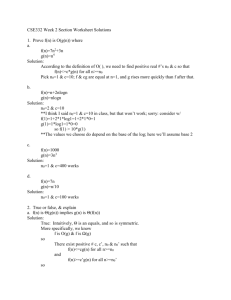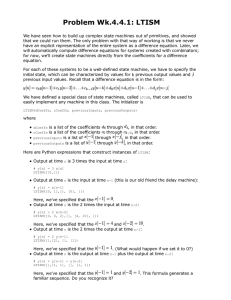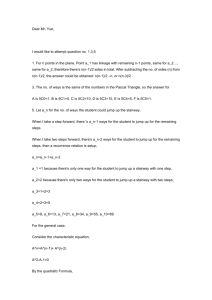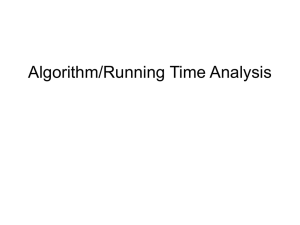Algo Chapter 3
advertisement
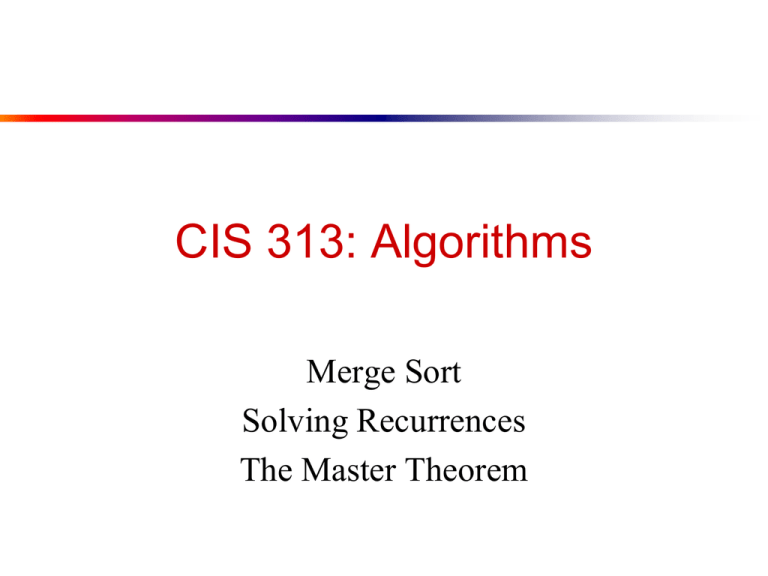
CIS 313: Algorithms
Merge Sort
Solving Recurrences
The Master Theorem
Merge Sort
MergeSort(A, left, right) {
if (left < right) {
mid = floor((left + right) / 2);
MergeSort(A, left, mid);
MergeSort(A, mid+1, right);
Merge(A, left, mid, right);
}
}
// Merge() takes two sorted subarrays of A and
// merges them into a single sorted subarray of A
//
(how long should this take?)
Merge Sort: Example
Show MergeSort() running on the array
A = {10, 5, 7, 6, 1, 4, 8, 3, 2, 9};
Analysis of Merge Sort
Statement
Effort
MergeSort(A, left, right) {
if (left < right) {
mid = floor((left + right) / 2);
MergeSort(A, left, mid);
MergeSort(A, mid+1, right);
Merge(A, left, mid, right);
}
}
So T(n) = (1) when n = 1, and
2T(n/2) + (n) when n > 1
So what (more succinctly) is T(n)?
T(n)
(1)
(1)
T(n/2)
T(n/2)
(n)
Recurrences
The expression:
c
n 1
T ( n)
n
2T cn n 1
2
is a recurrence.
Recurrence: an equation that describes a function
in terms of its value on smaller functions
Recurrence Examples
0
n0
s ( n)
c s(n 1) n 0
0
n0
s ( n)
n s(n 1) n 0
c
n 1
T ( n)
2T n c n 1
2
c
n 1
T ( n)
n
aT cn n 1
b
Solving Recurrences
Substitution method
Iteration method
Master method
Solving Recurrences
The substitution method (CLR 4.1)
A.k.a. the “making a good guess method”
Guess the form of the answer, then use induction
to find the constants and show that solution works
Examples:
= 2T(n/2) + (n) T(n) = (n lg n)
T(n) = 2T(n/2) + n ???
T(n)
Solving Recurrences
The substitution method (CLR 4.1)
A.k.a. the “making a good guess method”
Guess the form of the answer, then use induction
to find the constants and show that solution works
Examples:
= 2T(n/2) + (n) T(n) = (n lg n)
T(n) = 2T(n/2) + n T(n) = (n lg n)
T(n) = 2T(n/2 )+ 17) + n ???
T(n)
Solving Recurrences
The substitution method (CLR 4.1)
A.k.a. the “making a good guess method”
Guess the form of the answer, then use induction
to find the constants and show that solution works
Examples:
= 2T(n/2) + (n) T(n) = (n lg n)
T(n) = 2T(n/2) + n T(n) = (n lg n)
T(n) = 2T(n/2+ 17) + n (n lg n)
T(n)
Solving Recurrences
Another option is what the book calls the
“iteration method”
Expand the recurrence
Work some algebra to express as a summation
Evaluate the summation
We will show several examples
0
n0
s ( n)
c s(n 1) n 0
s(n) =
c + s(n-1)
c + c + s(n-2)
2c + s(n-2)
2c + c + s(n-3)
3c + s(n-3)
…
kc + s(n-k) = ck + s(n-k)
0
n0
s ( n)
c s(n 1) n 0
So far for n >= k we have
s(n) = ck + s(n-k)
What if k = n?
s(n) = cn + s(0) = cn
0
n0
s ( n)
c s(n 1) n 0
So far for n >= k we have
s(n) = ck + s(n-k)
What if k = n?
s(n) = cn + s(0) = cn
0
n0
s ( n)
c s(n 1) n 0
So
Thus in general
s(n) = cn
0
n0
s ( n)
n s(n 1) n 0
=
=
=
=
=
=
s(n)
n + s(n-1)
n + n-1 + s(n-2)
n + n-1 + n-2 + s(n-3)
n + n-1 + n-2 + n-3 + s(n-4)
…
n + n-1 + n-2 + n-3 + … + n-(k-1) + s(n-k)
0
n0
s ( n)
n s(n 1) n 0
=
=
=
=
=
=
s(n)
n + s(n-1)
n + n-1 + s(n-2)
n + n-1 + n-2 + s(n-3)
n + n-1 + n-2 + n-3 + s(n-4)
…
n + n-1 + n-2 + n-3 + … + n-(k-1) + s(n-k)
n
=
i
i n k 1
s(n k )
0
n0
s ( n)
n s(n 1) n 0
So far for n >= k we have
n
i
i n k 1
s(n k )
0
n0
s ( n)
n s(n 1) n 0
So far for n >= k we have
n
i
s(n k )
i n k 1
What if k = n?
0
n0
s ( n)
n s(n 1) n 0
So far for n >= k we have
n
i
s(n k )
i n k 1
What if k = n?
n 1
i s (0) i 0 n
2
i 1
i 1
n
n
0
n0
s ( n)
n s(n 1) n 0
So far for n >= k we have
n
i
s(n k )
i n k 1
What if k = n?
n 1
i s (0) i 0 n
2
i 1
i 1
n
Thus in general
n 1
s ( n) n
2
n
c
n 1
n
T (n) 2T
c n 1
2
T(n) =
2T(n/2) + c
2(2T(n/2/2) + c) + c
22T(n/22) + 2c + c
22(2T(n/22/2) + c) + 3c
23T(n/23) + 4c + 3c
23T(n/23) + 7c
23(2T(n/23/2) + c) + 7c
24T(n/24) + 15c
…
2kT(n/2k) + (2k - 1)c
c
n 1
n
T (n) 2T
c n 1
2
So far for n > 2k we have
T(n) = 2kT(n/2k) + (2k - 1)c
What if k = lg n?
T(n) = 2lg n T(n/2lg n) + (2lg n - 1)c
= n T(n/n) + (n - 1)c
= n T(1) + (n-1)c
= nc + (n-1)c = (2n - 1)c
